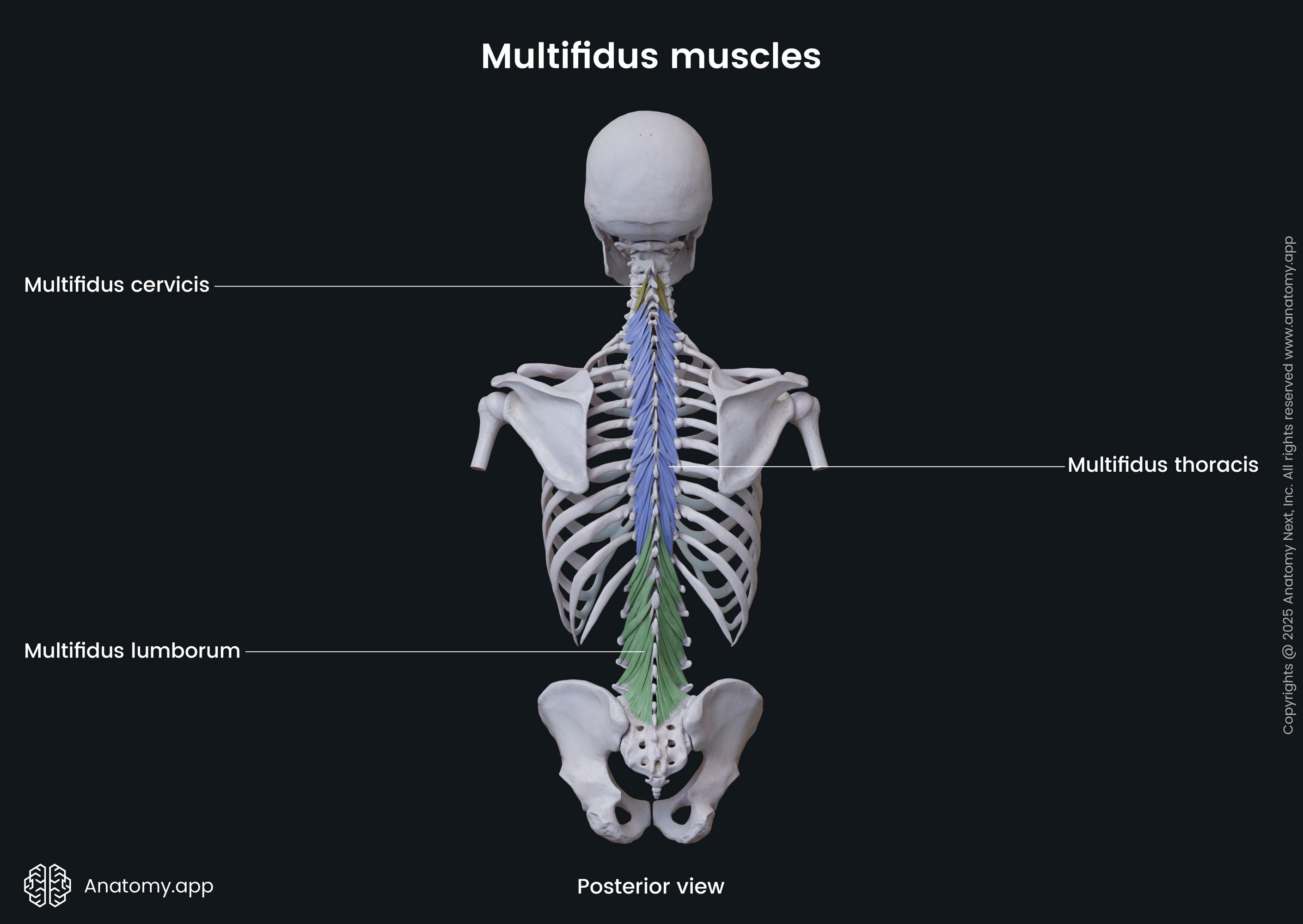- Anatomical terminology
- Skeletal system
- Joints
- Muscles
- Head muscles
- Neck muscles
- Muscles of upper limb
- Thoracic muscles
- Muscles of back
- Superficial back muscles
- Intermediate back muscles
- Deep back muscles
- Superficial layer
- Intermediate layer (Erector Spinae)
- Deep layer (Transversospinales)
- Deepest layer
- Muscles of lower limb
- Heart
- Blood vessels
- Lymphatic system
- Nervous system
- Respiratory system
- Digestive system
- Urinary system
- Female reproductive system
- Male reproductive system
- Endocrine glands
- Eye
- Ear
Multifidus
The multifidus muscle (Latin: musculus multifidus) is a group of relatively short and small triangular-shaped back muscles located on either side of the spine in the groove between the spinous and transverse processes of the vertebrae. Together with the semispinalis and rotatores, the multifidus muscles belong to the transversospinal group of the deep back muscles. All transversospinal muscles lie in the deep layer of the deep back muscles. The multifidus muscles are shorter than the semispinalis but longer than the rotatores. Moreover, they are the thickest muscles in the group.
Each multifidus muscle stretches between the transverse and spinous processes of vertebrae, and they span over three to six vertebral levels. The multifidus muscles extend from the cervical to the lumbar spine. Therefore, the multifidus muscles are subdivided into three portions based on the spine regions they occupy. These portions are named the multifidus cervicis, multifidus thoracis and multifidus lumborum.

Cervical multifidus
| Cervical multifidus | |
|---|---|
| Origin | Superior articular processes of C4 - C7 vertebrae |
| Insertion | Spinous processes of C2 - C5 vertebrae |
| Action | Bilateral contractions - extension of cervical spine Unilateral contractions - contralateral rotation of cervical spine, ipsilateral lateral flexion of cervical spine Stabilization of cervical spine |
| Innervation | Medial branches of dorsal rami of spinal nerves |
| Blood supply | Vertebral, deep cervical and occipital arteries |
Origin
The cervical multifidus muscles originate from the superior articular processes of the fourth to seventh cervical vertebrae (C4 - C7).
Insertion
The fibers of the cervical multifidus extend superomedially and insert on the spinous processes of the second to fifth cervical vertebrae (C2 - C5).
Action
Muscle contractions on both sides (bilateral contractions) extend the cervical spine, while contractions on one side (unilateral contractions) provide lateral flexion (ipsilateral) and rotation of the cervical spine (contralateral). Also, these muscles participate in stabilizing the cervical spine.
Innervation
The cervical multifidus muscles are innervated by the medial branches of the dorsal rami of the spinal nerves.
Blood supply
The multifidus muscles in the cervical region receive arterial blood supply mainly via the vertebral and deep cervical arteries, which arise from the subclavian artery and costocervical trunk, and the occipital artery - a branch of the external carotid.
Thoracic multifidus
| Thoracic multifidus | |
|---|---|
| Origin | Transverse processes of thoracic vertebrae |
| Insertion | Spinous processes of vertebrae 2 - 5 levels above origin |
| Action | Bilateral contractions - extension of thoracic spine Unilateral contractions - contralateral rotation of thoracic spine, ipsilateral lateral flexion of thoracic spine Stabilization of thoracic spine |
| Innervation | Medial branches of dorsal rami of spinal nerves |
| Blood supply | Dorsal branches of posterior intercostal and subcostal arteries |
Origin
The thoracic multifidus muscles arise from the transverse processes of the thoracic vertebrae.
Insertion
The muscle fibers of the thoracic multifidus extend superomedially and insert on the spinous processes of the vertebrae two to four, sometimes five levels above their origin.
Action
Muscle contractions on both sides (bilateral contractions) extend the thoracic spine, while contractions on one side (unilateral contractions) provide lateral flexion (ipsilateral) and rotation of the thoracic spine (contralateral). Also, these muscles participate in stabilizing the thoracic spine.
Innervation
The thoracic multifidus muscles are innervated by the medial branches of the dorsal rami of the spinal nerves.
Blood supply
The thoracic multifidus muscles are mainly supplied by the dorsal branches of the posterior intercostal and subcostal arteries, which are branches of the thoracic aorta.
Lumbar multifidus
| Lumbar multifidus | |
|---|---|
| Origin | Mammillary and transverse processes of lumbar vertebrae, dorsal surface of sacrum, posterior superior iliac spine, posterior sacroiliac ligament |
| Insertion | Spinous processes of vertebrae 2 - 5 levels above origin |
| Action | Bilateral contractions - extension of lumbar spine Unilateral contractions - contralateral rotation of lumbar spine, ipsilateral lateral flexion of lumbar spine Stabilization of lumbar spine |
| Innervation | Medial branches of dorsal rami of spinal nerves |
| Blood supply | Lumbar and lateral sacral arteries |
Origin
The lumbar multifidus muscles originate from the mammillary and transverse processes of the lumbar vertebrae and the dorsal surface of the sacrum. Additionally, some fibers also arise from the posterior superior iliac spine of the ilium and posterior sacroiliac ligament.
Insertion
The fibers of the lumbar multifidus extend superiorly and insert on the spinous processes of the vertebrae that are two to four, sometimes five levels above the origin sites.
Action
Muscle contractions on both sides (bilateral contractions) extend the lumbar spine, while contractions on one side (unilateral contractions) provide lateral flexion (ipsilateral) and rotation of the lumbar spine (contralateral). Also, these muscles participate in stabilizing the lumbar spine.
Innervation
The multifidus muscles are innervated by the medial branches of the dorsal rami of the spinal nerves.
Blood supply
The lumbar multifidus muscles are mainly supplied by the lumbar and lateral sacral arteries - branches of the abdominal aorta and internal iliac artery, respectively.